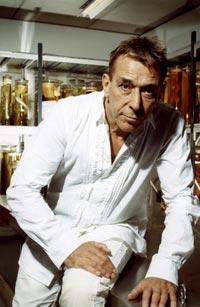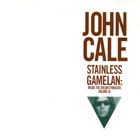

Album reviews

Stainless Gamelan: Inside the Dream Syndicate Volume III
Review by Ken Clark
In the third and final CD of the series of recordings from the 1960s made by Tony Conrad of John Cale's experimental music, further diversity is revealed. These pieces appear to have two components to them. Initially an instrumental background is established and then there is some improvisation around this. One can only wonder how this innovation may have evolved to given the opportunity to release it when it was recorded and further refine it in a more sophisticated studio environment, to say nothing of the potential influence on other artists. Certainly "The Academy in Peril" and "Church of Anthrax", two official "experimental" releases in the early 1970s by Cale subsequent to these recordings are relatively tame compared to the adventure contained in this collection. We can only thank the magic of compact disks and the paucity of current truly experimental work for the ability to hear this music.
What follows is a brief attempt to describe the pieces in this collection
- Stainless Steel Gamelan: John Cale and Sterling Morrison: Cembalet / Fretless Guitar: Like its title, this selection replicates the Balinese gamelan music electronically sounding much like the drone of a train through an empty landscape. A simple phrase is repeated over and over and variations are explored given the confines of the initial sounds established.
- At About This Time Mozart Was Dead and Joseph Conrad Was Sailing the Seven Seas Learning English: John Cale: Wollensak, John Cale and Sterling Morrison: Viola, Guitar. This piece sounds a bit like a radio caught between two stations. John Cale uses his famous Wollensak tape recorded to cut in and out of a jam with Sterling. At one point the familiar ever ascending drone takes over and the viola and guitar rise and rise until some very distorted viola playing, perhaps sped up breaks up the proceedings and scrambles all over the track. Eventually the distorted viola settles down but by then the underlying drone has completely changed and become almost machine like. As this track is very long, over 26 minutes, during which the viola is given further implosions that alter the underlying drone. Finally the sounds begin to resemble an aerial dogfight between mosquitoes and appropriately ends with what could be described as the drone of airplane engines.
- Terry's Cha-Cha: John Cale: Wollensak, Angus MacLise: Hand drums, tambourine, Terry Jennings: Soprano Saxophone. This is certainly the most conventional selection from all the CDs. It sounds like something you would hear at a fairground band shell at Coney Island in the 1930s. Very haunting and effective given its surrounding bedfellows. What sounds like an organ plays almost a waltz with the percussion tapping along, the sax merrily soloing in a conventional manner. Most unusual and effective.
- After the Locust: John Cale: Electric piano, Tony Conrad: Thunder machine. Cale plays a haunting electric piano, sounding as if it is being played in a large open room providing an eerie mood. At first there is a repeated simple melody that builds until the keys are stuck harder as the melody is performed faster and faster and louder and louder. The pace quickens and the piano becomes more and more distorted almost like a chase seen from Hitchcock. Then the drone blocks out the piano and both compete for attention as the pace accelerates again, louder faster, louder faster, more intense until prior to completion it stops, interrupted, unfinished.
- Big Apple Express: John Cale: Viola, tape, New York Fire Department: Vocal. A familiar drone is initiated and electronic sounds intermittently bleep across it, always returning to the same base sounds. The viola weaves its way around the sounds findings its place in the din. The underlying theme reveals greater subtlety as it moves along with almost a guitar sound cutting through now. Finally it ends with a New York fire department official telling Cale with several expletives to "turn it off". An appropriate way to end the collection.
This is another excellent selection of John Cale's early experimental works. One can only hope that there may be more in the vaults somewhere with Cale's many early avante garde collaborators among them, Tony Conrad, Lamonte Young, and Jon Hassell. There will never again be music quite like this.